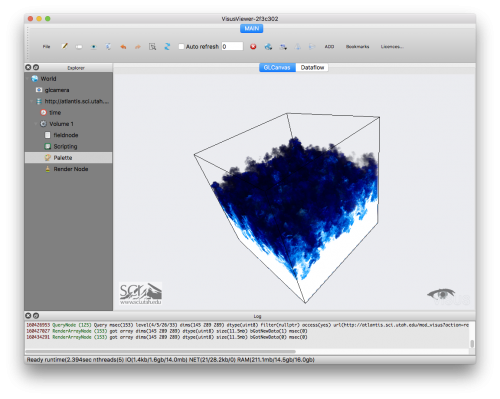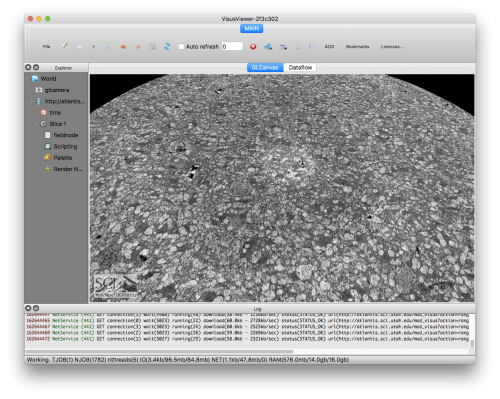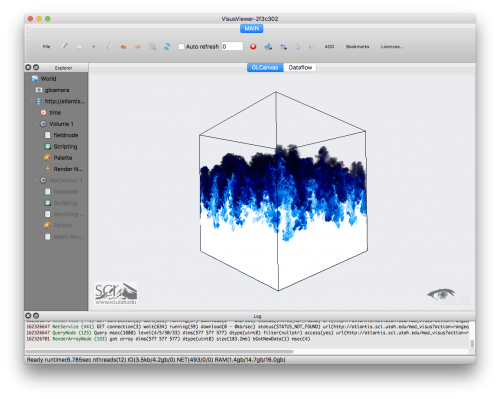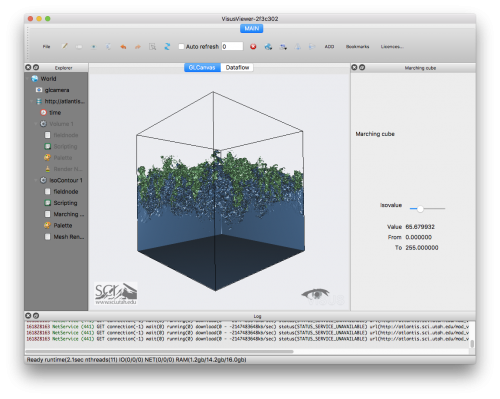ViSUS Viewer
Contents
Basic Usage
The default layout of the viewer looks like the following picture:
In the window you have:
- a toolbar that contains the most basic options
- a left sidebar that shows the tree of datasets and visualization/computing nodes used in your workflow. Each element in this sidebar is called *node*
- the canvas, where you can navigate and interact with the data
More windows can pop up to customize each node.
Open/Add a dataset
A dataset can be either local or remote (e.g. provided by a ViSUS Server).
Local dataset
Two options are available to open a local dataset in the menu File:
- Open file... (open a single file, all the datasets in the current session will be discarded)
- Add file... (add a dataset to the current session)
Remote dataset
Two options are available to open a remote dataset in the menu File:
- Open URL... (open a remote dataset, all the datasets in the current session will be discarded)
- Add URL... (add a dataset to the current session)
Try, for example, to open the Gigapixel 2D dataset David using this URL: http://atlantis.sci.utah.edu/mod_visus?dataset=david
And zoom in as you like!
Bookmarks and Configuration
A fresh ViSUS installation should provide in the Bookmarks menu a list of datasets that are publicly available. You can use those to experience some of the functionalities and performance of ViSUS Viewer or add your own IDX datasets using the ViSUS configuration file.
Advanced configuration (i.e. mostly performance and platform specific related) are also contained in the ViSUS configuration file.
Save/Open a scene
The current scene can be saved on disk using the File->Save scene... command. The scene will contain all the datasets and settings in the current session.
The current scene can also be saved as history that will contain also all the operation performed by the user in the scene (i.e. using File->Save history...).
The same scene can be later opened from File->Open file... and shared with other users (i.e. assuming other users can access the datasets in the scene using the same path/URL, this means that datasets might be remote or on a shared file system).
Nodes/Filters
When you open or add a new datasets you will get a tree of nodes on your left sidebar that will allow to define analysis and visualization pipelines.
The default Nodes are the dataset node that provides information about the dataset and the time node that allows to move along the timesteps contained in the datasets.
The main types of Node that the user can add are:
- Slice Node, creates a slice selection of the dataset and related rendering pipeline
- Volume Node, creates a volume rendering pipeline
- Iso Contour Node, creates an isocountour rendering node allowing the possibility to change isovalue interactively
- Scripting Node, allows the user to define execute interactively an analysis code on the input data or use one of the predefined scripts
You can add a Node using the menu Add.
Slice Node
The slice node renders a 2D slice.
For example if we open with ViSUS Viewer a 3D dataset like: http://atlantis.sci.utah.edu/mod_visus?dataset=rabbit3d
We will get the following slice rendering:
Volume Node
A volume node performs a volume rendering of the input data.
For example if we open with ViSUS Viewer the URL: http://atlantis.sci.utah.edu/mod_visus?dataset=borg
We can visualize the following volume rendering (timestep 15 using a "Ice" palette):
IsoContour Node
An iso contour node computes an iso surface at a certain input iso value.
For example if we open with ViSUS Viewer the URL: http://atlantis.sci.utah.edu/mod_visus?dataset=borg
We can visualize the following iso surface (isovalue ~65.68):
Collection of IDX datasets
Sometimes can be useful to define a collection of IDX dataset to use for interactive visualization or analysis. MIDX is file format that can define a collection of IDX files.
The simplest example of MIDX is the following:
<dataset typename='IdxMultipleDataset'> <dataset url='file://$(CurrentFileDirectory)/my_dataset.idx' name= 'pressure' /> <dataset url='file://$(CurrentFileDirectory)/my_other_dataset.idx' name= 'temperature' /> </dataset>
This MIDX simply defines two datasets that could be either locally or remote.
When you load an .midx file in ViSUS Viewer you will have a new element in you Nodes which is the "Field Node". In an MIDX since you have several input datasets the field node is responsible to select the input of your Node (e.g. a volume rendering node). So you can either choose one of the inputs:
A=input[0]; output=A;
or even combine them to produce a derived data input as in the following example (interleaved):
A=input[0]; B=input[1]; output=Visus.Array.interleave([B,B,B,A]);
In this example we created an array that is made of 4 components. We can map those four component to the RGBA channels of our palette enabling "Enable palette" on the Render Node. In this example this allows to control the visualization of B using the data in A simply varying the alpha channel in the Palette Node.
Here are some other examples:




